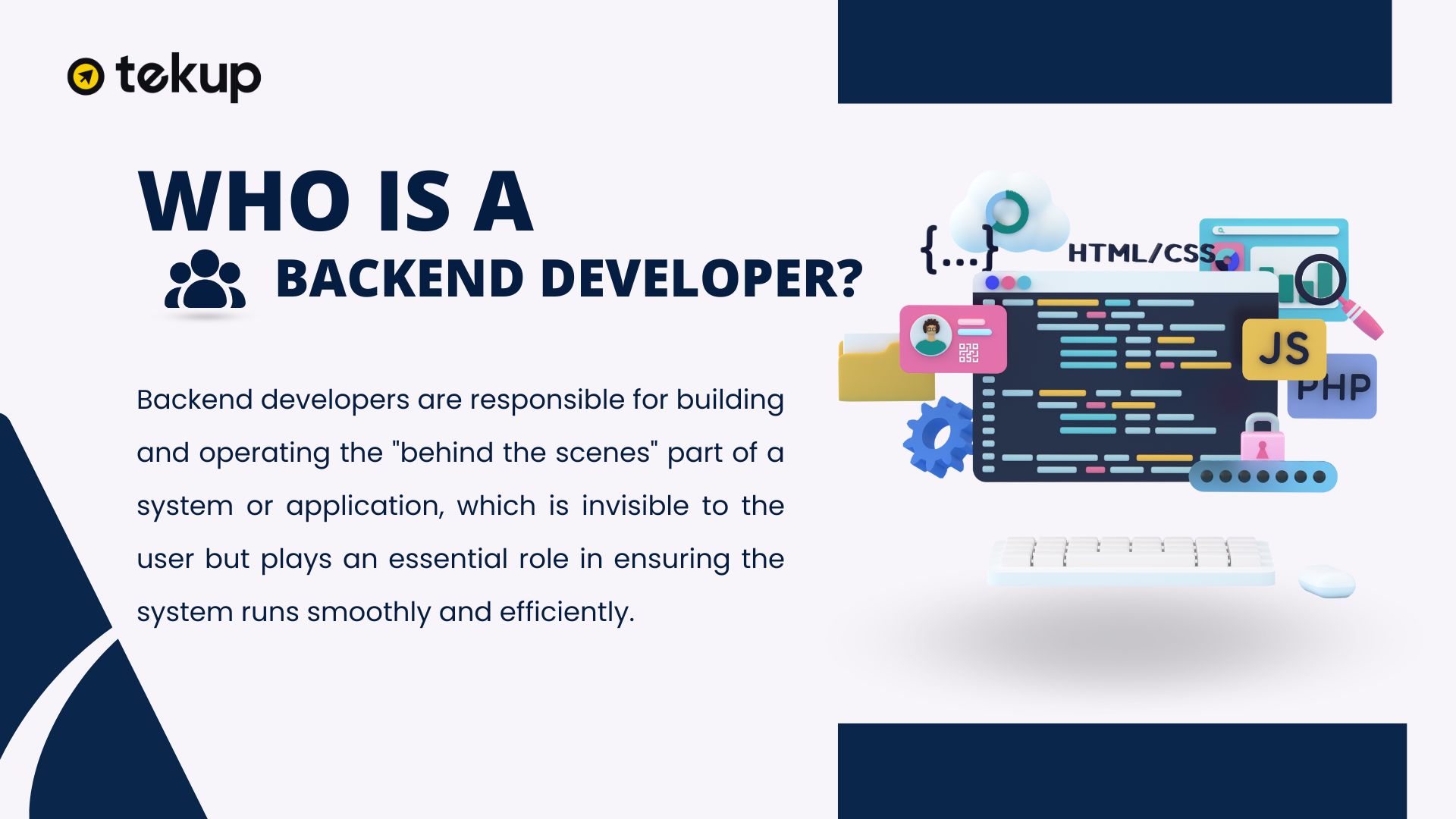Introduction
In modern life, accessing websites or applications to work and stay updated seems to have become an indispensable part of our daily routine, doesn’t it? Every website or application we use operates through two main components: Frontend and Backend. If the Frontend represents what users see and interact with, the Backend is the “brain” that ensures everything runs smoothly and accurately.
But what exactly is Backend? And what skills do you need to become a professional Backend developer? Let’s explore these questions in this article!

What is Backend?
Backend is simply understood as the part of an application or website that handles the logic, data storage, and ensures that all functions operate smoothly. While the frontend is what the users see and interact with, the backend is the “brain” that runs everything behind the scenes.
Explore more useful articles on our website! Don’t forget to visit regularly to stay updated on the latest technology knowledge and IT career development tips.
In the system, the Backend is responsible for:
1. Handling requests from the frontend and returning results
When a user performs an action on the interface, such as clicking the “search” or “login” button, these requests are sent to the backend. The backend will:
- Receive the request: Through protocols like HTTP or WebSocket.
- Process the business logic: Analyze the request and determine what needs to be done. For example, when searching for a product, the backend will query the database to find matching products.
- Return the result: The processed data will be returned to the frontend in the form of JSON or XML for display to the user.
Example: When a user types the keyword “tekup” in the search bar of a website, the backend will search for products with that keyword in the database and return the matching list.
2. Database Management (Create, Update, Delete Data)
One of the core tasks of the Backend is to manage the database, which stores all the system-related information. The Backend acts as a bridge to perform operations like adding, editing, or deleting data. Here’s a breakdown of each task:
2.1. Create Data (Create)
When new information comes in from users or the system, the Backend will save it into the database. This ensures that the data is organized and easily retrievable in the future.
Example:When a user registers an account, the Backend stores personal information (name, email, password) in the user database. The password is typically encrypted for security.
Real-life Application: E-commerce websites like Shopee and Lazada store order or product information when users add items to their shopping cart.
2.2. Update Data (Update)
As the system operates, data often needs to be updated to reflect the current state or new information. The Backend ensures that modifications are made accurately without affecting other data.
Example: When a user changes their phone number or password, the Backend finds and updates that information in the database.
Real-life Application: When a customer requests a change in the delivery address, the Backend updates the new address in the order database.
2.3. Delete Data (Delete)
When data is no longer needed, the Backend will delete it to free up resources and prevent the database from being overloaded.
Example: When an account is canceled, the Backend removes all related information from the database.
Real-life Application: Email services like Gmail allow users to delete unnecessary emails, and the Backend handles the deletion process.

3. Ensuring Data Security and User Authentication
Security is a critical factor in any technology system, especially in the Backend, where sensitive user information is stored and processed. The Backend ensures security and authentication through various methods to protect data from threats like hackers, malware, or unauthorized access.
3.1. Methods for Ensuring Security:
- Data Encryption: Sensitive information such as passwords, personal data, or bank account details is encrypted to prevent exposure if data is stolen. Example: When you enter your password, the Backend converts it into a hashed string rather than storing it directly.
- Access Control: The Backend assigns specific permissions to different user groups, ensuring that only authorized individuals can access or manipulate certain data. Example: Only administrators have permission to delete user accounts.
- Secure Protocols: Protocols like HTTPS or TLS ensure that data transmitted over the network is encrypted and safe from interception.
3.2. User Authentication Process:
- Login Authentication: The Backend checks the account credentials (email, password) against the stored data. If correct, the system grants access. Example: When you log into a banking app, the system verifies your account and sends an OTP (One-Time Password) for verification.
- Two-Factor Authentication (2FA): This requires an additional authentication step beyond the password, such as an OTP or fingerprint verification, to strengthen security.
- Login Activity Monitoring: The Backend logs unusual login activities and notifies the user to prevent unauthorized access.
4. Integration with External Services or APIs
Backend systems do not operate in isolation; they often need to connect with external services to expand functionality and optimize performance. Integrating with APIs or third-party services allows systems to perform complex tasks without the need to build everything from scratch.
Benefits of API Integration:- Time and Resource Savings: Leveraging available services helps reduce development time and costs. Instead of reinventing the wheel, developers can use pre-built services to quickly implement features.
- Enhanced Functionality: By connecting with services such as payment gateways, maps, or data analytics, the Backend can offer users a more comprehensive experience. For example, integrating payment APIs like PayPal or Stripe enables secure online transactions without developing payment systems in-house.
- Increased Flexibility: APIs allow easy replacement or upgrading of services without affecting the entire system. For instance, switching to a more efficient analytics service can be done with minimal disruption to other parts of the system.
In this way, the Backend not only handles internal requests but also serves as a “bridge” to connect applications with advanced services, ultimately improving operational efficiency and user experience.
Who is a Backend Developer?

A Backend Developer is responsible for building and maintaining the “behind-the-scenes” part of a system or application. This area, though invisible to users, plays an essential role in ensuring that the system runs smoothly and efficiently. Their work revolves around data processing, business logic, and integrating with other components to create a seamless user experience.
Main Roles of a Backend Developer:
1.1. Writing Code for Business Logic:
Backend Developers design and write code that handles the core logic of an application. This is the “brain” that processes user requests and helps the system understand and respond to them.
1.2. Optimizing System Performance:
Performance is a key factor in ensuring that an application runs quickly and can handle a large user base. Backend Developers optimize the source code, manage resources, and use tools to measure and improve system performance.
1.3. Building and Maintaining Databases:
Backend Developers design databases to store critical information such as user data, products, orders, etc. They ensure that the database is well-organized, easy to query, and secure.
1.4. Ensuring Security and System Stability:
Security is a top priority in Backend development. Developers must ensure that user information is protected and that the system is not vulnerable to attacks. They also monitor the system to detect and fix any technical issues promptly.
Backend Developers are not only coders but also the architects who build the solid foundation needed for applications to run effectively, safely, and reliably. Their work requires precision, creativity, and the ability to quickly solve problems, contributing to a smooth experience for the end users.
What skills does a Backend Developer need?
To become a good Backend Developer, you need to develop both technical and soft skills. Here are the essential skills:
Technical Skills (Hard Skills)
Backend Programming Languages
Backend developers must be proficient in at least one popular programming language such as:- JavaScript (Node.js): Popular for its flexibility and ability to handle both Backend and Frontend efficiently.
- Python: Known for its easy syntax, ideal for data processing and artificial intelligence.
- Java: Widely used in large systems due to its stability and scalability.
- PHP: Popular for web development due to its ease of integration with databases.
- Ruby: Flexible and efficient, suitable for startup applications.
Database Knowledge
- Knowledge of how to design and manage databases like MySQL, PostgreSQL, MongoDB, or Redis.
- Ability to write complex SQL queries and optimize query performance.
- Understanding how to efficiently organize data and implement relationships between tables.
Understanding of Networking Protocols and APIs
- Proficiency with HTTP, HTTPS, WebSocket protocols.
- Ability to build and work with RESTful APIs or GraphQL to connect the Frontend and Backend.
Systems and Servers
- Understanding how to deploy, configure, and manage web servers like Nginx, Apache.
- Experience with cloud services like AWS, Google Cloud, or Azure.
- Using Docker and Kubernetes to deploy and manage applications in a containerized environment.
Security Knowledge
- Understanding encryption techniques, authentication, and authorization.
- Knowledge of how to protect against common vulnerabilities like SQL Injection, XSS, or CSRF.

Soft Skills
Problem Solving
Backend Developers often face complex situations related to data, performance, or technical errors. Analytical skills and the ability to quickly find solutions are crucial.
Logical and Systematic Thinking
Understanding how to organize components within a system and predict potential issues in advance.
Teamwork
Backend Developers frequently collaborate with Frontend, QA, and DevOps teams. Good communication skills help ensure smoother workflows.
Ability to Learn
Backend technology is constantly evolving. Developers need to be open to learning and adapting to new technologies such as microservices, serverless, or modern frameworks.
To succeed in the role of a Backend Developer, it’s not only important to master technical skills but also to develop teamwork and problem-solving abilities. The combination of expertise and systematic thinking will help you build robust and efficient Backend systems.

A Backend Developer is the heart of every technology system, ensuring that applications run smoothly, securely, and efficiently. They not only need to be proficient in programming languages, databases, and security but also must possess strong logical thinking and an ability to continuously learn. If you’re passionate about building a solid foundation for tech products and enjoy solving complex technical challenges, Backend is the ideal path for you to advance your career in the IT industry. Start your learning journey today to become a professional Backend Developer!
Explore more useful articles on our website! Don’t forget to visit regularly for the latest tech knowledge and IT career development tips.



